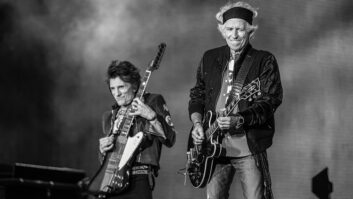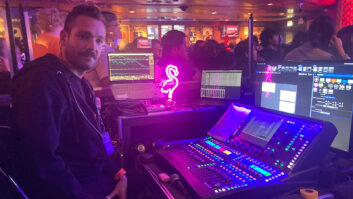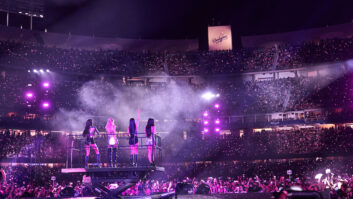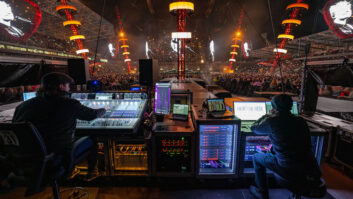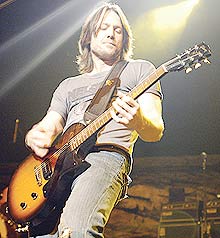
When many big pop acts put on a show, it typically calls for a heavily choreographed routine. Such acts follow a tight script that’s filled with large production numbers, dancers and special effects. For Keith Urban, one of the biggest names in contemporary country music, putting on a show means doing it the old-fashioned way: working hard to win over the crowd, changing up the set with new arrangements — in short, making it anything but routine. This was evident at New York City’s Madison Square Garden, one of the first stops on the Love, Pain and the Whole Crazy Carnival Ride tour featuring co-headliners Urban and Carrie Underwood. The tour began in January and will be making stops across the U.S. before heading to Urban’s native Australia and then finishing up Stateside this month. During his performance, Urban ran from one end of the stage to the other, up and down a runway and often into the audience, where he let fans touch him as he took guitar solos. At one point, he even unplugged his axe, signed it and gave it to a dumbfounded fan.
Urban’s front-of-house engineer, Steve Laws, has been with the singer (minus a few breaks) since Urban started out on Australia’s club scene 20 years ago. Admittedly, Urban’s old-school Aussie club chops are enhanced by very new-school technology, in particular a 60×40-foot high-definition video wall that adds some fancy imagery and close-ups of the band.
The tour is carrying a Clair Bros. P.A., with the new “bow-tie” subs, eight i4s as side hangs in large arenas and a pair doing frontfills. “There’s always a zone in the center that no matter what concert you go to is the worst seat in the house,” Laws says. “So we put a pair of i4s there, stacked on the subs, making it punchy down in the front. We have a couple of smaller P2 cabinets doing outfills on the very end of the runway on the sides, just for the people way close in the front. It’s very consistent sonically from venue to venue. It doesn’t throw a lot of junk off the back. It’s a great system.”
However, the nucleus of the show remains Urban’s spontaneous, crowd-engaging style. “He’s known for grabbing the mic and going out into the audience, which is always fun,” says Spence. “The biggest trick was coming up with a game plan for his spontaneity to make sure he had a mic when he was out in the crowd and by the time he got back up onstage. So we have six vocal mic positions for him between the main stage, the B stage and the piano position. Whatever he’s closest to, he grabs it and goes.” The mics — Shure Beta 87 capsules with Shure U4D receivers and U2 transmitters, along with a KSM9 as the main stage mic — often see abuse in the line of duty. “He goes out into the audience, grabs a mic and sings on it; now when it’s time for him to play guitar, the mic just gets thrown,” Spence says, “so they’re a little dinged up. We’re on a rotation of getting ’em repaired, but it makes it fun for the audience.”
“Both Jason and I have to be on our toes a lot because he’ll do audibles,” adds Laws. “He’ll just call a song, and we’ve got to be ready to go. It doesn’t happen a lot, but it does happen.” What’s more, the band changes instruments frequently. During the show, Urban plays electric and acoustic guitars, banjo and bass, and his bandmembers switch between acoustic and electric guitars, banjo and mandolin. In addition, the band plays a second, mostly acoustic set on a raised platform at the end of a runway in the center of the arena, which has its own setup (and during which more instrument switching occurs). In all, Spence and Laws must deal with a massive 104 inputs. “I do a lot of awards shows, and I don’t have that many inputs coming from [them],” Spence says.
To handle the FOH mix, Laws uses a DiGiCo D5 console. “I’d still rather have an analog system at the end of the day, but it’s really impractical, especially now,” he says. “It’s also a space-saving thing. I’d basically need two [Midas] XL4s to make the whole thing work, and the amount of real estate I’d take up would be obscene.
“I use the onboard EQ,” Laws continues. “I’m not big on using too many inserts or too many outboard devices, especially on a digital console; that kind of defeats the purpose of why you got the thing in the first place. Not only that, you can introduce latency, and then trying to compensate for that. I know a lot of people who don’t compensate for it, and personally I can hear it.
“The only outboard I use is a [Lexicon] 480L. There’s not many things around that can do what a 480L does. I use a medium hall setting, and I use a snare plate or a wood room on the snare drum. I have a [Tech 21] SansAmp guitar preamp I use to distort the drum kit for a couple of songs, and also the bass guitar for a couple of songs. It gives it a little edge. [For] the drum kit, I have [Empirical Labs] Distressors on the kick and snare, simply because there’s nothing like that inside the DiGiCo. I’ve also got the ADK [Pro Audio] computer with the Universal Audio card, so I can access LA-2As and 1176s and things like that, but it’s through the DiGiCo without having to go through any kind of conversion.” Laws sends the rest of the drum kit through a stereo pair to an Empirical Labs EL7 Fatso audio processor, “which really makes the drums leap out of the mix,” he adds.
Laws groups Urban’s six vocal channels together and inserts Crane Song Trakker Class-A compressor/limiters across the group. “[It’s] a studio device, primarily, but probably one of the most awesome compressors I’ve ever used,” he says. “I’ve got two of the Trakkers, and I also have an STC-8 [Crane Song stereo compressor], which I use over bass and guitar. There’s a few touring guys that use the STC-8 on bass; it’s really one of the best bass guitar compressors out there. The Trakkers are a little different — more of a mastering compressor and really good at handling vocal transients without any kind of coloration. It does have a lot of options. It’s basically every compressor that you’ve ever used built into one compressor.”

At stage-left, Spence is mixing on a Yamaha PM1D dual engine with LMY4-MLF mic/line input cards with 5k preamps, clocked with an Apogee Big Ben. “It’s the only reliable console that can handle the inputs and outputs that we’re running,” he says.
“All the FX are onboard,” Spence continues. “I do have the [Yamaha] REV-X ‘verbs installed in there. I’m running Version 2 on the 1D. There’s a really cool 1176 emulator on there that I use on a few inputs; that works quite well. There’s a tape-saturation emulator, which is great for putting on kick drums — it emulates slamming analog tape and gives you that punch.”
Sharing the Yamaha PM1D as a surface with Spence is Underwood’s monitor engineer, Cam Beachley. “I have my own wireless rack and output cage for the PM1Ds so that we’re not having to repatch,” he says. “Jason and I really thought about this, what would be most effective and speedy.
The band uses Future Sonics custom ear buds with MG4 drivers with Sennheiser EW 300 IEM G2 in-ear transmitters and receiver packs. The drummer uses a hardwired Shure PSM 600 pack. “[The Future Sonics] are probably my favorite of all the in-ears, because they don’t scoop out the mids,” Spence says. “It’s not an armature, it’s a real driver. No dual-driver, no triple-driver: it’s one driver, 20 kHz.”
“Everybody’s wearing Future Sonics right now, and we’re using Sennheiser G2 transmitters and receivers,” Beachley adds. “Everybody’s in-ears; we’ve got two subs up on the deck, and the bass player’s using a wedge as a faux bass amp.”
In addition to the in-ears, Urban listens to Showco Prism SRM wedges suspended underneath a center-stage grating. “He tends to pull one ear out and switches back and forth,” Spence says. “It started out just as feel, but as he started pulling an ear out to get the crowd, it started becoming more of a full mix in there.”
Spence also uses multiple pairs of mics to pick up the audience: Shure VP88 stereo mics and Shure 91s at FOH, a pair of KSM32s downstage and a second pair facing the back of the arena behind the B stage. “It’s an interesting balance to try to achieve in the ears between getting the isolation you need, but then also not so isolated that your mix is just sterile,” he says. “So we use quite a lot of audience mics, and if it’s a good-sounding room, often I’ll leave the audience mics up in the mix all night long, and then I’ll just ride ’em harder or in between songs just to get that crowd reaction.”
Urban’s electric guitar rig runs through two Royer 122 ribbon mics and two Sennheiser MD 409s, which go separately through two pairs of Neve 1073 preamps to Universal Audio 1176s, and finally to an Apogee AD-8000 that converts the signal into AES.
Doing FOH duties for co-headliner Carrie Underwood is Rob Rankin, who mixes on a Midas XL4. “Everything is available to me, as opposed to a digital console, where lots of stuff is buried. I’m old school,” he says unapologetically. “It’s mostly about her vocal and keeping up the band to support it.” Underwood’s vocals go through a Shure SM57, and then to an Empirical Labs DL8 Distressor and an XTA stereo dynamic EQ to help with sibilance.
Beachley adds that there is no need for him to treat Underwood’s voice. “Nothing on her vocals, flat EQ,” he confirms. “She’s an awesome singer, has great microphone technique. No compression, no nothing. She’s the real deal.”
Gaby Alter is a New York City-based writer.
FULL MIC LIST
Kick: SM91
Kick: ATM 25
Wendel
Snare Top: SM57
Snare Bottom: SM57
Hat: AKG 451
Rack: Opus 87
Floor: Opus 87
Ride: KSM-141
O/H Stage Right: VP-88
O/H Stage Left: VP-88
Bass DI: Demeter DI
Synth L: Radial JD-6
Synth R: Radial JD-6
Nord L: Radial JD-6
Nord R: Radial JD-6
Piano L: Radial JD-6
Piano R: Radial JD-6
Recpt L: Radial JD-6
Recpt R: Radial JD-6
Whirly: SM57
Leslie Low:– 421
Leslie High L: SM57
Leslie High R: SM57
Ed Electric guitar Mic L: 421
Ed Electric guitar Mic R: SM57
Ed Acoustic: RF
Carrie Electric guitar: SM57
Carrie acoustic guitar: RF
Spare Vocal: UR2/SM58
Carrie Vocal 1: UR2/SM58
Carrie Vocal 1: UR2/SM58
Carrie Vocal 1: UR2/SM58
Carrie Vocal 1: UR2/SM58
Carrie Vocal 1: UR2/SM58
Carrie Vocal 1: UR2/SM58
Carrie Vocal 1: UR2/SM58
Carrie Vocal 1: UR2/SM58
Fiddle: RF
Mandolin: RF
Jim Acoustic Guitar: RF
Shawn Electric Guitar Mic L: 421
Shawn Electric Guitar Mic R: SM57
Shawn Acoustic Guitar: RF
Steel: SM57
Dobro: RF
Banjo: RF
Pro Tools Pad L: Radial JD-6
Pro Tools Pad R: Radial JD-6
Pro Tools Loop L: Radial JD-6
Pro Tools Loop R: Radial JD-6
Pro Tools Percussion: Radial JD-6
Pro Tools Click: Radial JD-6
Track Vocal: Radial JD-6
Click 2: 1/8-Mini Adapt
Mark Talkback
Jon Talkback
Aud SL
Aud SR
Monitor TB
FOH TB




